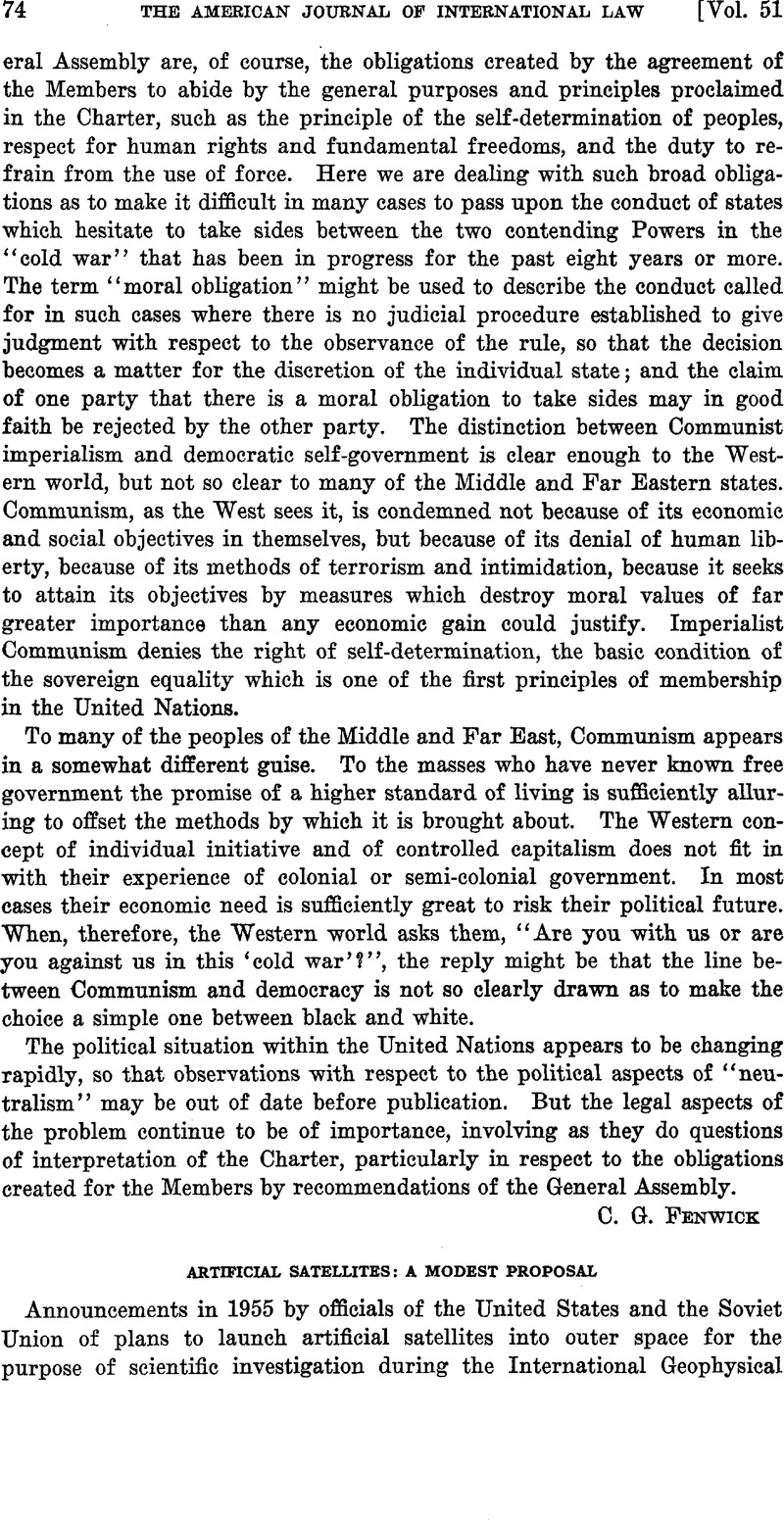Published online by Cambridge University Press: 28 March 2017

1 The U. S. announcement was made July 29, 1955. For text see 33 State Dept. Bulletin 218 (1955) and New York Times, July 30, 1955. First indication of the Soviets' intent to launch a satellite came on April 15, 1955, with the report that a committee of Soviet scientists had been established to pursue this objective. More recently, in September, 1956, the U.S.S.R. presented a brief report of its intent to the Special Committee for the International Geophysical Tear at a meeting in Barcelona and announced that its detailed program of participation in the satellite phase of the International Geophysical Tear would be presented later.
2 New Tork Times, Dec. 2, 1956, Sec. E, p. 11, col. 7.
3 Some indication of the scientific purposes to be served can be gathered from the various reports in the New Tork Times, July 30, 1955. And see Van Allen (ed.), Scientific Uses of Earth Satellites (1956).
4 1956 A.S.I.L. Proceedings 84–115.
5 Jenks, , “International Law and Activities in Space,” 5 Int. and Comp. L. Q. 99 (1956)CrossRefGoogle Scholar; Cooper, , “Legal Problems of Upper Space,” 1956 A.S.I.L. Proceedings 84 Google Scholar; Schachter, “Who Owns the Universe?”, Collier's, March 22, 1952, p. 36.
6 Jenks (note 5 supra) 103–104.
7 See Art. 8 of the International Civil Aviation Convention, regarding pilotless aircraft, and the Rorne Convention of 1952 on Aircraft Damage to Persons and Property on the Surface. Some manifestation of the type of difficulty which may arise in the future occurred during the writing of this editorial when a guided missile, the Snark, launched by the U. S. Air Force in Florida, failed to respond to its electronic control and presumably crashed in the jungle in Brazil. This type of missile does not rise into outer space. The Snark resembles an un-manned “air-breathing” aircraft. See New York Times, Dec. 8, 1956, p. 1, col. 1. In a later report it was stated that the “runaway guided missile” created a “sensation” in Brazil. It was indicated that the episode might have effects on negotiations between the two countries. New York Times, Dec. 9, 1956, p. 18, col. 1.
8 Such measures might allay apprehension of harm in a manner comparable to the design of the “open skies” proposal. See Note, “The Aerial Inspection Plan and Air Space Sovereignty,” 24 Geo. Wash. L. Rev. 565 (1956)Google Scholar.
Proposals have been made to ban testing of the intercontinental ballistic missile. Testimony of Senator Flanders in Hearings, Subcommittee on Disarmament, Committee on Foreign Relations, 84th Cong., 2d Sess., p. 81 (March 7, 1956); Leghorn, , “Controlling the Nuclear Threat in the Second Atomic Decade,” 12 Bulletin of Atomic Scientists 189, 195 (1956)CrossRefGoogle Scholar; Inglis, “National Security with the Arms Race Limited,” ibid. 196. A news story in the Washington Post, Dec. 10, 1956, stated that “administration sources disclosed” that “the White House had approved a new international disarmament plan which proposes that the use of long-range guided missiles for war be outlawed.”
For suggestions with respect to international control of satellites during the International Geophysical Year, see Leghorn, loc. cit. 195, and Romulo, , “Alphabet of the Apocalypse,” 39 Saturday Review 26, 51 (Dec. 8, 1956)Google Scholar.